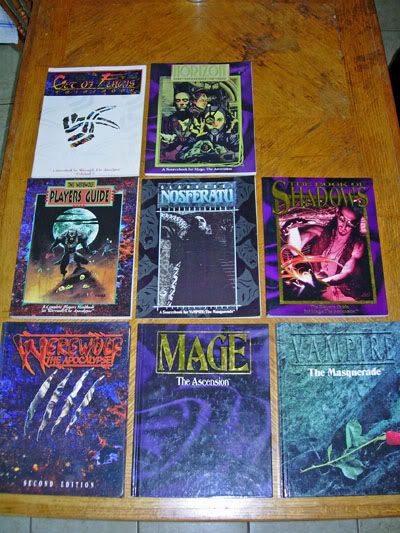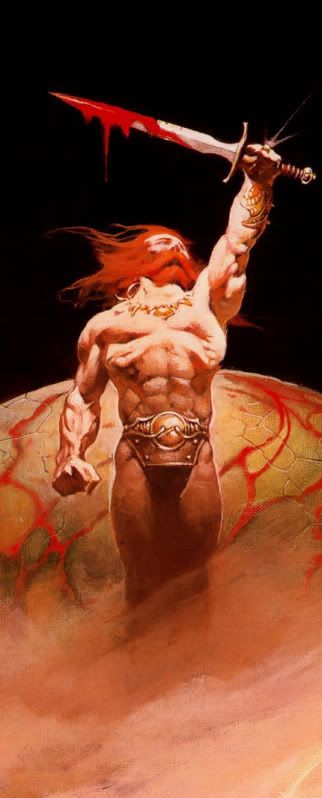Singular events of great moment, or the presence of objects of power or importance, magical, divine, infernal, or otherwise, leave impressions on the arcane aethosphere of Wyrd Oerth. Mighty works of magic, godly visitations or devilish intrusions, great conflicts or acts of infamy, leave behind them sumps, eddies, vortices, undertows, or other such disturbances in the normal ebb and flow of eldritch energies about the world.
These disturbances result in zones of magical alteration where normal spell casting is both dangerous and unpredictable. Any particular alteration zone will have a given % chance of causing a spell mishap to occur should an unwary magic-user attempt spell craft within its area of effect. This chance is determined by the Dungeon Master and should reflect the magnitude of the event which caused the aetheric impression originally.
If a spell is cast within an alteration zone, and a mishap is indicated, it may take several forms.
• A simple
spell failure is possible. The spell’s energies are drawn into the disturbance with no effect.
• A
spell alteration may take place. In some random fashion, the spell’s characteristics are altered. A fireball for example could manifest as a stream of flame that runs along the ground rather than a sphere which flies to its target. Alterations could potentially be helpful or a dangerous hindrance. The fire-stream in the above example could set other objects or persons alight as well as damage its intended target.
• An
arcane wildfire could occur. In this case the spell runs out of control. It’s duration, range, area of effect, or power level could triple, quadruple, or the spell could become a permanent manifestation. In this last case, the spell is now drawing energy in a self sustaining manner from the currents about the arcane disturbance itself and has gone beyond the casters ability to end or control.
• A
backfire may result. In this case the spell turns back upon the caster, delivering its full effect upon him.
• An
unrelated magical manifestation accompanies the spell. A rainbow appears, sprites infest the casters beard, a wagon sized turd falls from the sky, etc. I employ parts of the 2E wild magic rules for this result.
• A
spell-ghost occurs. This is not an undead spirit, but a re-manifestation of a spell which was cast previously within the alteration zone. The spell-ghost will take the form of a randomly determined spell which acts at one half of its standard strength. If the spell normally affects a target creature, the Dungeon Master must randomly determine who among the PCs and NPCs present the recipient of the magic is. If the random spell is one that increases in strength by level, the Dungeon Master must also determine the original casting level.
• A
revelation strikes the spell caster. Previous or future events connected to the location of the alteration zone are revealed to the caster in an instantaneous vision. The caster is also stunned for 1d4 rounds.
• An
arcane reverberation occurs. A wave of magical energy washes out from the locus of the alteration zone. This wave does no damage, but will be felt by all magic-using creatures within 1-100 miles, (2d10), of the disturbance. The reverberation will draw the attention of any such creature or person and may spur them to investigate its source. The reverberation will also be felt on both the astral and ethereal planes, as well as any other such plane which borders directly the prime material.
Famous magical alteration zones in Wyrd Greyhawk include, the Swords of the Old Gods, The Black Spiral of Ket, and the Mirror Water Pools. I intend to detail all of these in future posts.
When designating any particular space as a magical alteration zone, the Dungeon Master may roll 1d8 to choose the nature of potential mishaps, assign percentile chances to each possibility, or simply pre-choose which effect will be manifested in accordance with the circumstances of the zones origin.
If a magic-user is aware of the existence of a given magical alteration zone, he may cast spells normally within its area of effect if, before each attempt at casting, he successfully Saves VS Magic. Otherwise, a spell mishap is certain to occur.
Because of the danger presented by the existence of alteration zones, as well as the generally inconstant nature of magic in Wyrd Greyhawk, most masters include in their apprentices spell books a spell known as,
Discern Arcane Aethography
Level: 1
Range: Visual range of caster
Duration: 1 round
Area of Effect: N/A
Components: V, S
Casting Time: 3 rounds
Saving throw: N/A
If a magic-user has some indication or suspicion that the currents of magic are disturbed or unsettled in a given area due to past magic or other influences, the casting of Discern Arcane Aethography will reveal to him the nature of the disturbance and also what effect it may have upon his own spell casting.
As example, Sugraid the Spindly casts Discern Arcane Aethography upon encountering an ominous arch of living trees deep within the Old Forest. This reveals to him that spell casting here will result in an arcane reverberation unless he first Saves VS Spell successfully before each casting. As Sugraid has no wish to reveal his location or presence, he must refrain from magic-use within the alteration zones area of effect.
Magic-users with an Intelligence score of 16 or above who cast Discern Arcane Aethography prior to casting a second spell in areas outside of magical alteration zones will gather enough of a feel for the shape of magic in their immediate area that the following spell will act as though the magic-user were one level of experience higher than he actually is.
Remlap’s Arcane Inscriptor
Level: 3
Range: Centered directly upon caster
Duration: permanent
Area of Effect: up to a 10’ diameter circle, dependent upon available space.
Components: V, S, M
Casting Time: 6 rounds when pre-cast, 1 segment when activated.
Saving Throw: N/A
When activated, the Arcane Inscriptor instantly burns a magic circle, pentagram, thaumaturgic triangle, or other designated protective inscription into the surface the caster stands upon. Regardless of the nature of the surface, stone, wood, a grassy lawn, a lake, the chosen design will appear complete, unbroken, and legible. This inscription is permanent and may not be broken or erased.
The major portion of this spell is first cast in a secure location, with the magic-user drawing the desired protective inscription on the floor by hand. Then the spell is carried in the casters mind and only activated by the uttering of its final word.
The design created by the Arcane Inscriptor enhances the power of a single spell which is cast after its creation. The inscription created, and the spell enhanced by it must be related. A magic circle will enhance the spell, protection from evil, a pentagram will enhance summoning/binding spells, and a thaumaturgic triangle will enhance divinatory magic.
Specifics are left to the individual Dungeon master to tailor to their own taste.
Call forth the Guryms
Level: 2
Range: 20’
Duration: 1d6 rounds per level
Area of Effect: all within reach of the Guryms
Components: V, S, M
Casting Time: 1 round
Saving Throw: N/A
This spell when cast summons 1d4 of the Guryms per level of the caster. Creatures of the fey underworld, the Guryms are unaffected by other monster summoning spells or magic. Only this specific spell can call them to the prime material plane. The Guryms are completely and utterly uncontrollable. Immune to charm, hold, suggestion, paralysis, binding, or other such magic, they naturally possess an aura of
free action and may not be physically bound, restrained, or contained. The caster will have no influence over the actions of the beastly little men. At the end of the given spell duration, the Guryms will fade back to their own dimension.
The Guryms appear as two and a half foot tall, extremely hairy men with disproportionately large heads, blazing blue eyes, and wide mouths filled with sharp teeth. They wear kilts or short pants but no other clothing.
When they appear, their actions are determined randomly. They may, attack all present, revel wildly, steal all things they lay hands on, eat anything ingestable, destroy all objects they can reach, or create art. Roll 1d8 to determine.
Guryms, AC: 4, Hit Dice: 2, Move: 140’ per round, Alignment: Chaotic, Special: unharmed by non-magical weapons, Those face slapped by a gurym will join them in whatever activity they are engaged in until they return to the fey underworld.
Clear the Air.
Level: 3
Range: 60’
Duration: 3 rounds
Area of Effect: Whatever enclosed space the caster occupies, or, 1000 cubic feet of outdoor space, per level
Components: V, S
Casting Time: 6 segments
Saving Throw: None
When this spell is cast, a stiff breeze of pure, cool air blows through the immediate area about the caster and instantly clears the air of smoke, smog, dust, spores, steam, gas or vapor and renders it clean and breathable.
The action of the spell also ends the effects of any magic which causes such atmospheric contamination, such as, stinking cloud, as well as shielding the caster from poison gas attacks such as green dragon breath.
The spell functions in a metaphoric sense as well. Clear the Air will also put an end to Charm and Suggestion or other such mind affecting magic. Recipients of the spell’s benefits may also feel a sense of clarity and inspiration. What may come of this is left to the Dungeon Master to decide.







